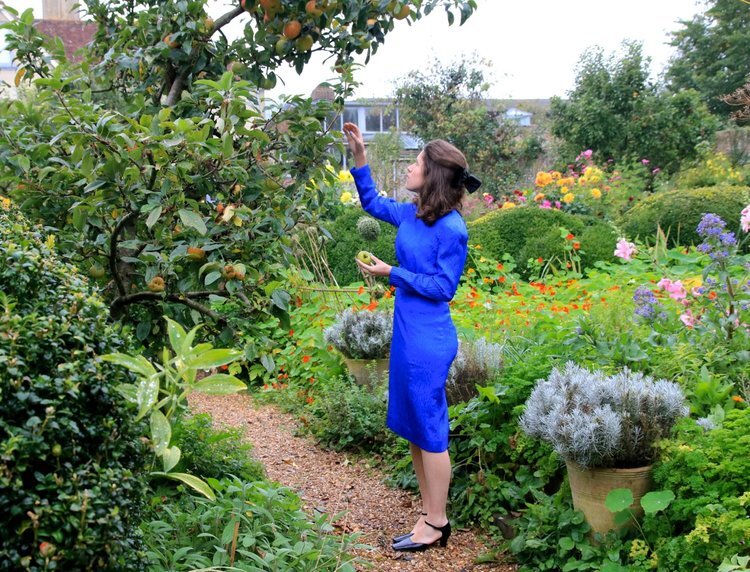Bitter Vetch
Lathyrus linifolius
Fabaceae
25th May 2020
I came across this little wildflower in one of my favourite reading spots in the garden. There is a grassy bank just below the pond that slopes fairly steeply down to a little stream, and it happily catches the afternoon sunlight each day.
I had visited this spot a number of times this spring, but settling myself in one day, I noticed that I was surrounded by tiny pink and blue flowers. I couldn’t quite believe my eyes - it always seems to me extraordinary that a plant can produce flowers of different colours on the same stem, but here they were. A pinky purple flower on top, with a purple tinted blue just below. And so many of them, settled there on the bank, enjoying the sunshine.
The flowers were so delightful, reminding me of little butterflies with brightly coloured translucent wings, or of minute George O’Keeffe orchid-esque painted petals. So small and unimposing, and so beautiful!
I gathered a couple for a vase, and sending a photo through to some friends almost immediately found out their name (a nifty plant finder app used by a plant loving friend) - Bitter-vetch, and confirmed in the Collins Complete British Wildflowers as Lathyrys linifolius.
Although incredibly informative, every time I read a Collins plant entry, I am always yearning for something more ‘HEIGHT to 50cm...Found in grassy places, heaths and woods, mainly on acid soils... FLOWERS 15mm long, red fading to blue or green… LEAVES Comprising 2-4 pairs of narrow leaflets...STATUS Extremely Local’ but none of this tells me their story - are they just a pretty wildflower that happily grows in this country and is admired by those that discover it, or have they ever been put to any sort of use.. do they taste bitter, were they a key ingredient in a witches potion, or did they adorn the flower crown of a fairytale princess... So many questions!
What Collins did tell me is that they are part of the Fabaceae (or Leguminosae) family, so their relations are legumes, peas and beans and they feature a distinctive seedpod, known as a ‘legume’. And as a friend pointed out, they do rather resemble rather delightful tiny garden sweet peas (lathyrus odoratus).
The Domino Guide of Wildflowers of Britain & Ireland calls them Bitter-vetchlings (which I rather like!), the reason being ‘The current official name, Bitter Vetch, is confusing, since having winged stems, it is not a Vetch, and its old name Tuberous Pea (Lathyrus tuberosus) has been assigned to the Fyfield Pea’ - an interesting piece of information - a controversial name change!
To make this clearer a Vetchling differs from a Vetch only in botanical detail - vetchlings have winged stems and fewer pairs of leaflets, however they do sit under different genera, Collins Dictionary tells us:
Vetchling:
‘any of various leguminous tendril-climbing plants of the genus Lathyrus, esp L. pratensis (meadow vetchling), mainly of N temperate regions, having winged or angled stems and showy flowers’
Vetch:‘any of various climbing leguminous plants of the temperate genus Vicia, esp V. sativa, having pinnate leaves, typically blue or purple flowers, and tendrils on the stems’
The English word ‘Vetch’ comes from the French name for the plant fecche, deriving from old French veche, which originally comes from the Latin vicia.
And Vicia is the classical Latin name for Vetch, possibly from Latin vincio, to bind, in reference to the clinging tendrils of many of the vetches.
And - just to tidy up the etymology -
Lathyrus is from the ancient Greek word for a leguminous plant - lathyros - λάθυρος - also thought to translate directly as ‘very passionate’.
So Bitter Vetch is a vetching in botanical structure, known commonly as a vetch.
Richard Mabey (whose books I always love so much!) discovered a few more fun facts noted in his Flora Britannica, including that the Bitter-vetch’s fleshy-root tubers were originally gathered for food, and in Scotland it was sometimes used for flavouring whisky. The Revd Angus Macfarlane, who enjoyed the tubers as a form of chewing gum, wrote in 1924 that the taste was ‘both acid and sweet, and never palls’.
There are also whole websites dedicated to it being an appetite suppressant (supposedly Charles I gave it to his mistresses to help keep them trim, if you believe the Daily Mail) - but I am not sure I want to go down too much of the herbal medicine route. If you do wish to eat the tubers, remember to boil them first as they can be slightly toxic!
So not quite witches potions or fairytale princesses - but what a pretty flower, keep an eye out for it. It flowers from April to July in the UK, so you have lots of time left to find it.
Alice x





